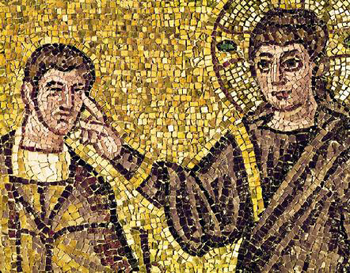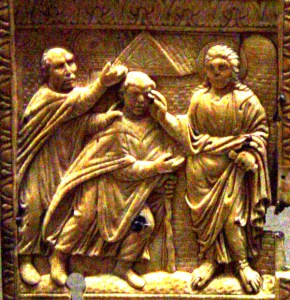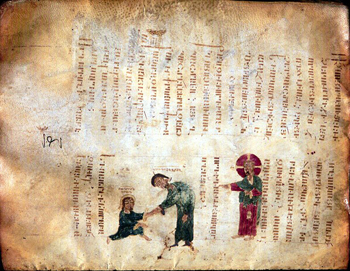From Our Archives
Debie Thomas, Happily Ever After (2021); Debie Thomas, Let Me See Again (2018).
This Week's Essay
For Sunday October 27, 2024
Lectionary Readings (Revised Common Lectionary, Year B)
Psalm 34:1–8, (19–22) or Psalm 126
Hebrews 7:23–28
Mark 10:46–52
By my count, there are three distinct stories in the gospels where Jesus heals a blind man. This is an iffy number, because it's obvious that sometimes the writers told the same stories in different ways to make different points to different audiences.
In Matthew 9:27, Jesus healed "two blind men" by touching their eyes.
In Mark 8 and John 9, Jesus healed a man at Bethsaida by spitting and making mud that he applied to the man's eyes. In John's version, the physical healing provokes a much longer discourse about spiritual blindness — an important reminder that Jesus's miracles are much more than magic tricks.
Then, in a story that occurs in all three synoptic gospels, there's the reading for this week about the healing of a blind man at Jericho (Mark 10, Matthew 20, and Luke 18). In Matthew's version of this story there are two men.
There are about thirty healing stories in the four gospels, and they are always anonymous. It's strange when you think about it. We never learn the name of the person who was healed. The only exception to this rule is the story about Lazarus in John 11. The most we ever learn is something once-removed like "Jairus's daughter." These people had names, of course, but we never learn them.
This anonymity is another tip-off that the writers weren't interested in mere spectacle. The miracles point beyond themselves to the more profound and mysterious identity of Jesus. He was more than a magician.
So, Mark 10:46–52 for this week is a rare exception; it's one of the two healing stories in which we learn the name of the person who was healed—Bartimaeus. And what a name! It's a name about which scholars have spilled a lot of ink, and for good reason. Mark uses some apparent word play with the name "Bartimaeus" to point beyond the miracle to the meaning of Jesus.
 |
|
6th Century Mosaic, Sant' Appollinare Nuovo, Ravenna.
|
Bar-Timaeus is a linguistic hybrid that's half Aramaic and half Greek. Mark knows that he has intentionally flummoxed his Gentile readers, and so in 10:46 he employs a favorite technique that he uses eight other times in his gospel (see references at the end of the essay). He gives us a parenthetical explanatory translation: "that is, the Son of Timaeus."
But what does that mean? Literally and simply, 10:46 thus reads, "son of Timaeus (that is, the Son of Timaeus)."
If "Timaeus" sounds vaguely familiar, you might be channeling your college philosophy class. Timaeus is the title of Plato's most famous dialogue and the name of its narrator. In the Timaeus and elsewhere, Plato famously contrasts "seeing" the mere physical world while being "blind" to Eternal Truths. Recall his allegory of people who are chained in a cave, and who consequently can "see" only fragments of reality because they are blinded by the darkness.
And so the blind Bartimaeus begs Jesus, "Rabbi, I want to see!"
In his book Philo of Alexandria and the Timaeus of Plato (1983), the classicist David Runia argues that "the Timaeus was the only Greek prose work that up to the third century A.D. every educated man could be presumed to have read." Had Mark read Plato's Timaeus? Or maybe even Jesus?
Is Mark contrasting Platonic Greek philosophy with the Jewish Jesus for his Gentile audience? It's such a tantalizing suggestion. In the book of Acts and in 1 Corinthians, both Luke and Paul draw sharp contrasts between Greek philosophy and the Jesus Story. But as the British like to say, for me, it's too clever by half. In my view, this interpretation is only a "definite maybe."
The name "Bartimaeus" suggests other linguistic possibilities. In simplest terms, the name combines the Aramaic "bar" (son) with the Greek "timaios" (honorable). So, Bartimaeus is a family name. He's just the son of a father named Timaeus. I like the simplicity of this observation that resists over-interpretation.
 |
|
Jesus heals the blind man, Andrews diptych, Carolingian, 9th-century.
|
More subtly and allegorically, though, his family name signifies that he is the "son of honor," or an honored person.
Still others point to the Aramaic or Hebrew word for "unclean" (br tm'), suggesting that Bartimaeus is the "son of the unclean."
I like to combine these ideas. Bartimaeus was a socially marginalized blind man who was "sitting by the roadside begging." (10:46). He might be dishonored as a public nuisance, marginalized by the sophisticated Greeks, and he might be unclean to ritually clean Jews, but in Mark's telling he's a person we should honor.
There's a good reason why Mark honors this dishonored man. Whereas "many people rebuked him and told him to be quiet" (10:48), trying to put him in his place, the blind Bartimaeus was insistent. Not once, but twice, he cries out, "Son of David, have mercy on me!"
Longing for help and healing, the Son of Timaeus confesses the Son of David. Here we have hit the theological pay dirt of this story.
The title "Son of David" is a loaded phrase that occurs seventeen times in the gospels. This is the only time that Mark uses it in his gospel. It hearkens back to the very first sentence of the New Testament, where in Matthew 1:1 we read that Jesus is the "son of David, son of Abraham."
The title "Son of David" that Mark uses to describe Jesus points us to more than a genealogical connection. It's a bold theological confession that makes a miraculous healing pale by comparison. Jesus is greater than Abraham. He's more than Moses, or even King David. He surpasses the justly famous Plato.
Jesus is the longed-for Jewish messiah mentioned in 2 Sam 7:12–13.
 |
|
Armenian illuminated mss of Jesus healing Bartimaeus, c. 11th century.
|
The story of Bartimaeus is the last healing in Mark. It's a transition story with a palpable sense of geographic movement. After the healing of Bartimaeus at Jericho, Mark pivots to the triumphal entry of Jesus into Jerusalem — and thus to the beginning of his passion week and the fulfillment of his mission.
Just before the Bartimaeus story, the disciples "were on their way up to Jerusalem" (10:32). With the healing of Bartimaeus, "they came to Jericho" (10:46). And after his healing, Bartimaeus "followed Jesus along the road" (10:52) as they "approached Jerusalem and came to Bethpage and Bethany at the Mount of Olives." (11:1).
As with virtually all the characters in the gospels, we never hear about Bartimaeus again. But with Mark's description of how he followed Jesus those seventeen miles from Jericho to Jerusalem, I like to picture the Son of Timaeus confessing the Son of David, walking with him to the City of David. And as the images that I've added to this essay show, he lived on in the artistic memory of the church.
Bartimaeus invites us to the same journey of "following Jesus on the way," and to the same confession, "Jesus, Son of David, have mercy on me!"
NOTE: For Mark's nine parenthetical explanatory translations, see Mark 3:17, 5:41, 7:11, 7:34, 12:42, 15:16, 15:22, 15:34, 15:42.
Weekly Prayer
Taken from The Valley of Vision: A Collection of Puritan Prayers & Devotions, edited by Arthur Bennett.
Lord, high and holy, meek and lowly,
Thou hast brought me to the valley of vision,
where I live in the depths but see Thee in the heights;
hemmed in by mountains of sin I behold Thy glory.
Let me learn by paradox that the way down is the way up,
that to be low is to be high,
that the broken heart is the healed heart,
that the contrite spirit is the rejoicing spirit,
that the repenting soul is the victorious soul,
that to have nothing is to possess all,
that to bear the cross is to wear the crown,
that to give is to receive,
that the valley is the place of vision.
Lord, in the daytime stars can be seen from deepest wells,
and the deeper the wells the brighter Thy stars shine;
let me find Thy light in my darkness,
Thy life in my death,
Thy joy in my sorrow,
Thy grace in my sin,
Thy riches in my poverty,
Thy glory in my valley.
Dan Clendenin: dan@journeywithjesus.net
Image credits: (1) At the Edge of the Enclosure; (2) Gospel Renegades; and (3) Index of Armenian Art, Fresno State University.





